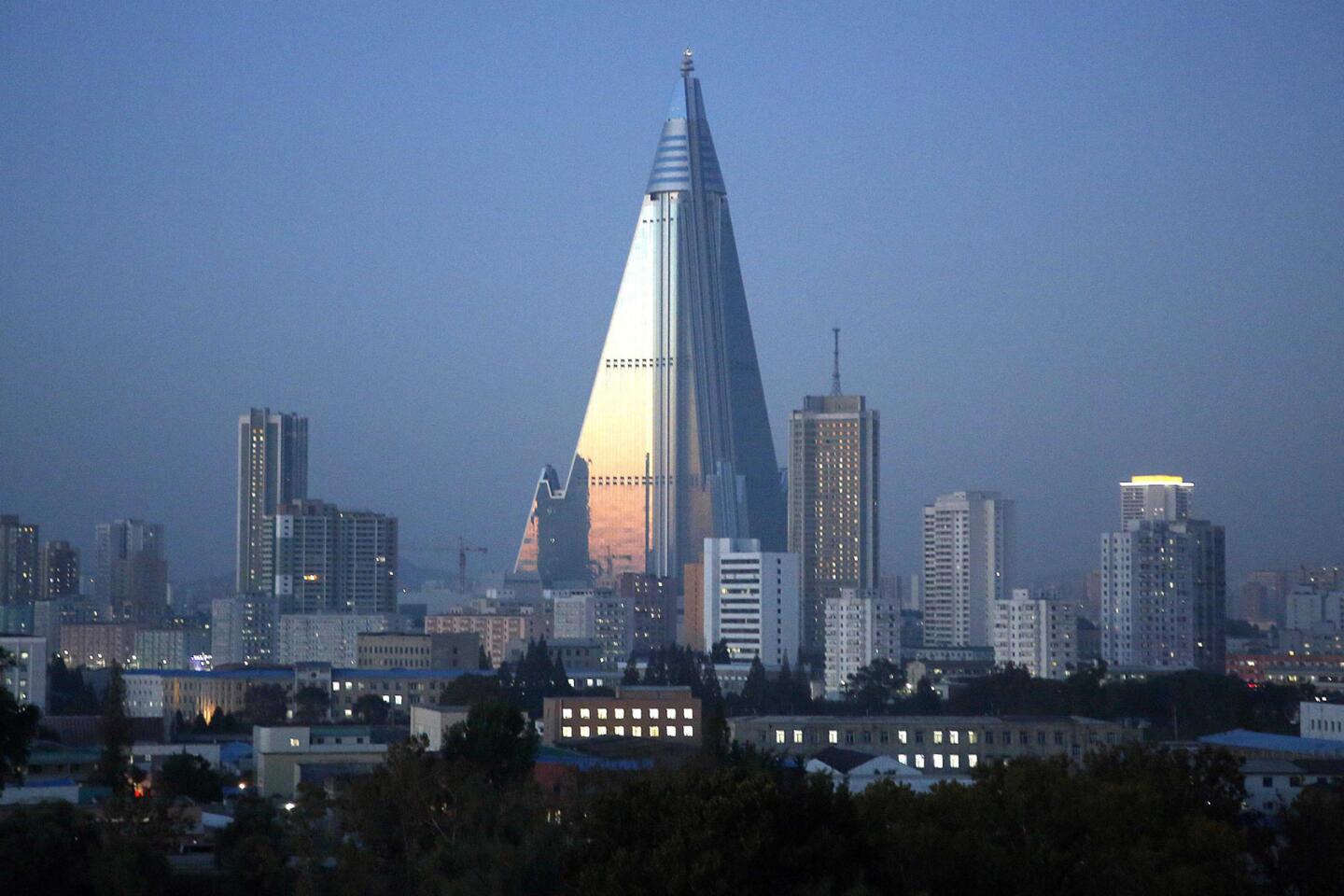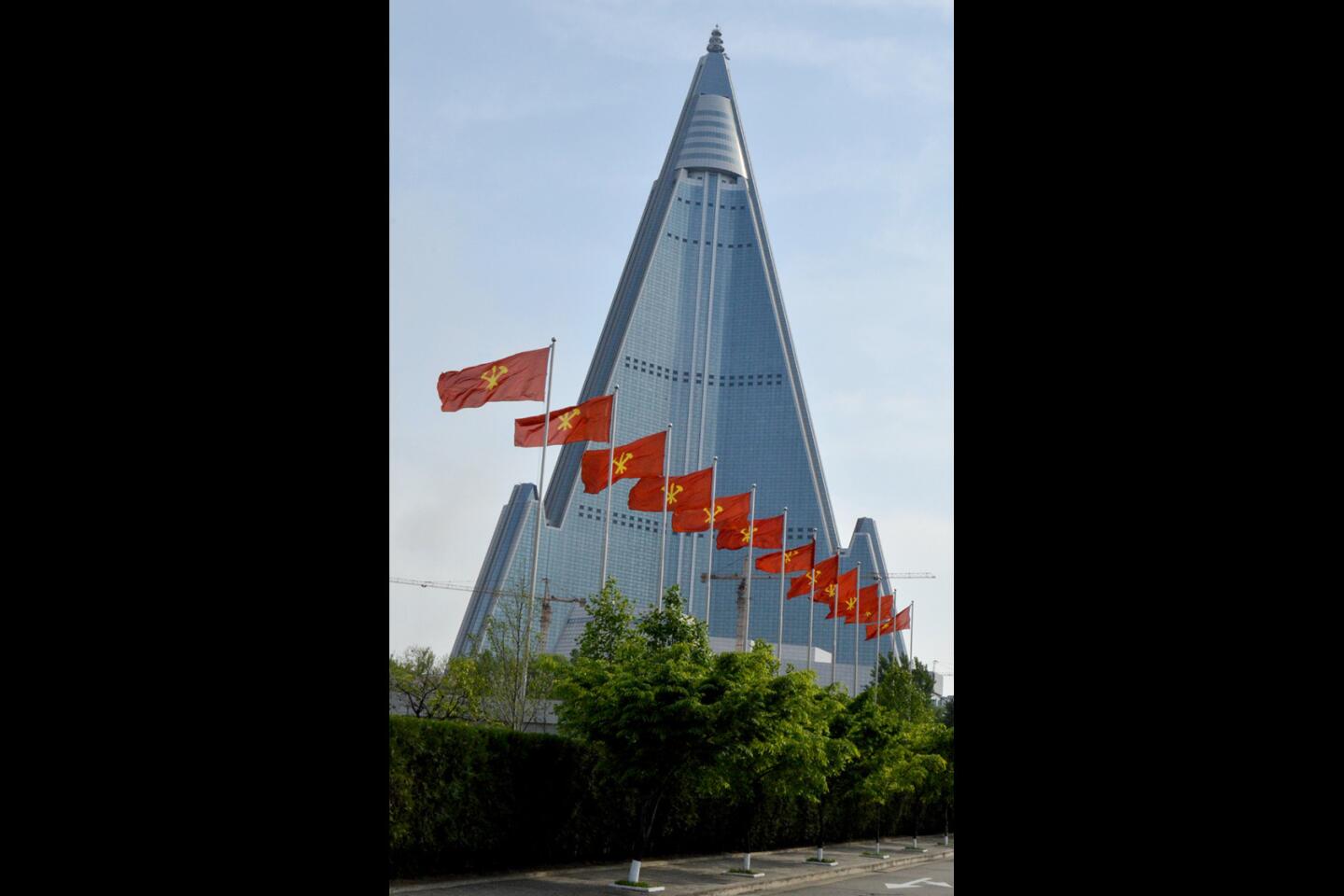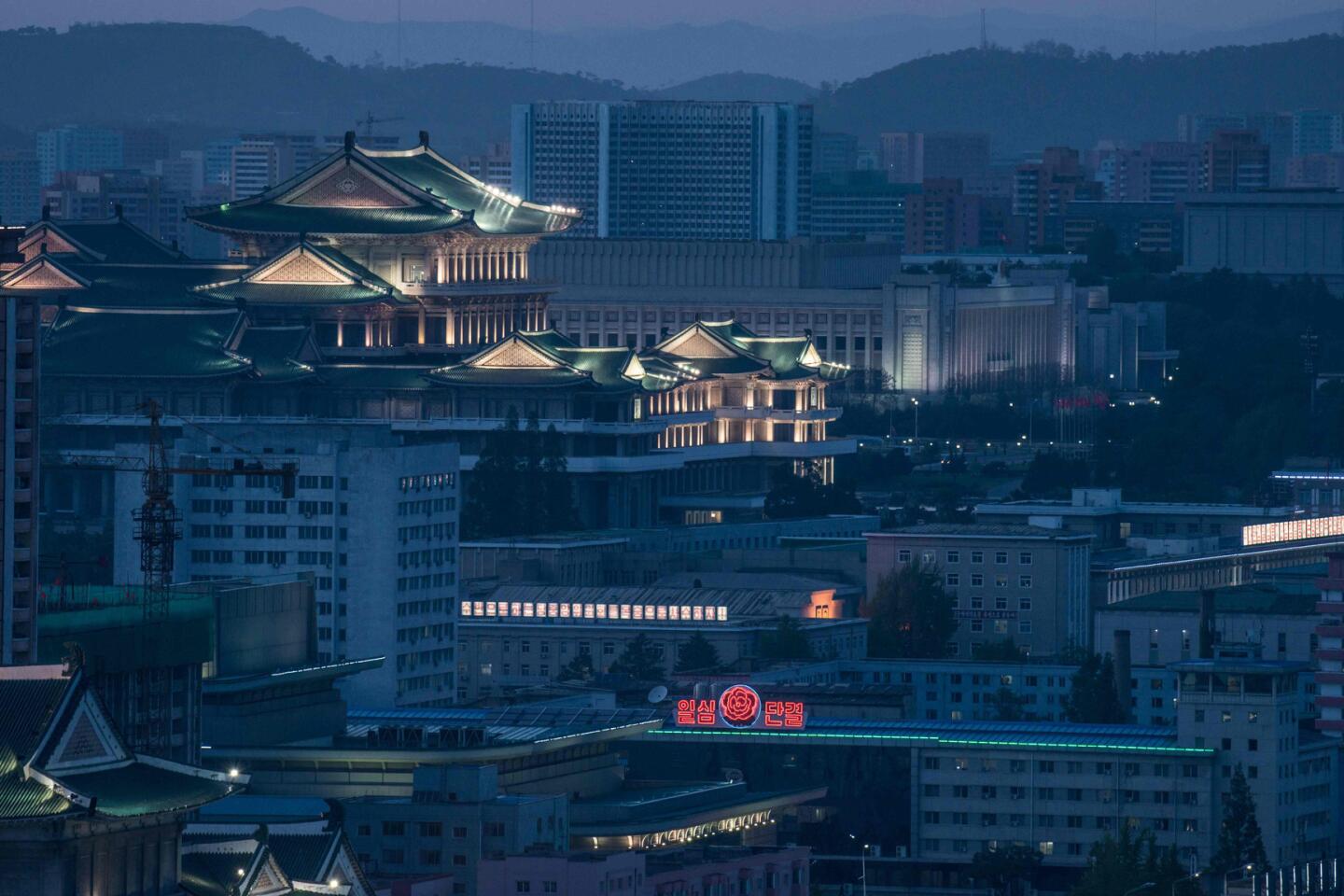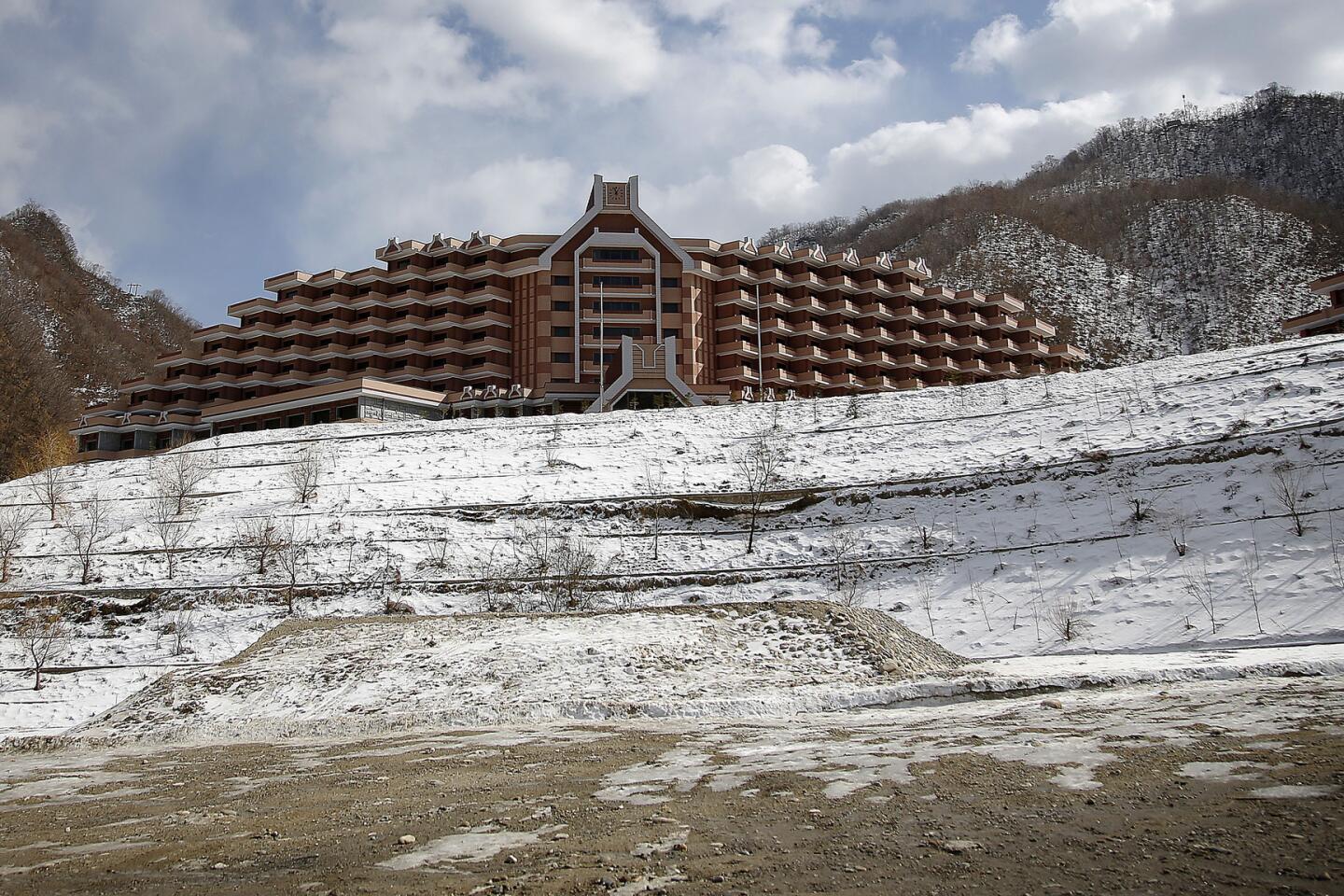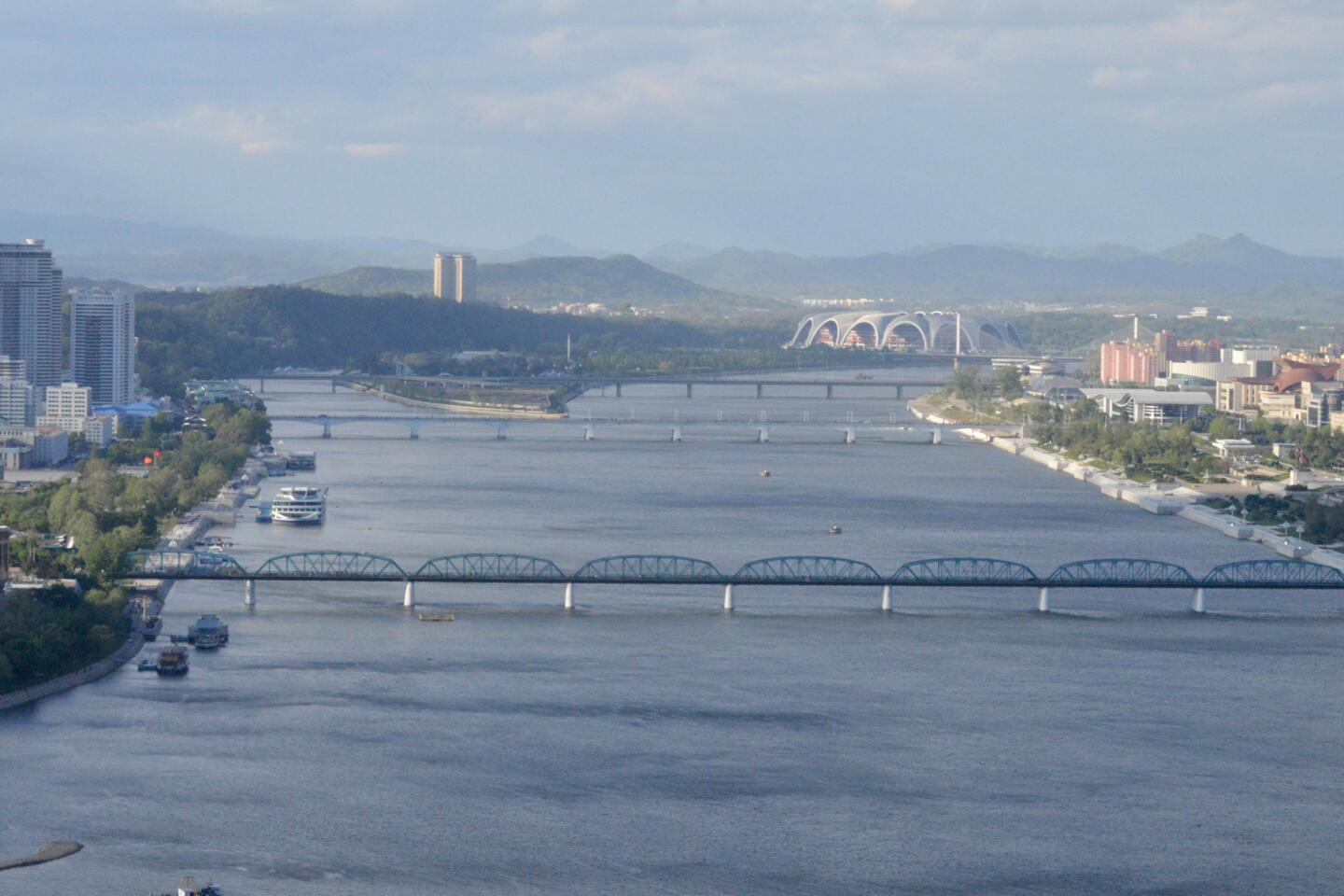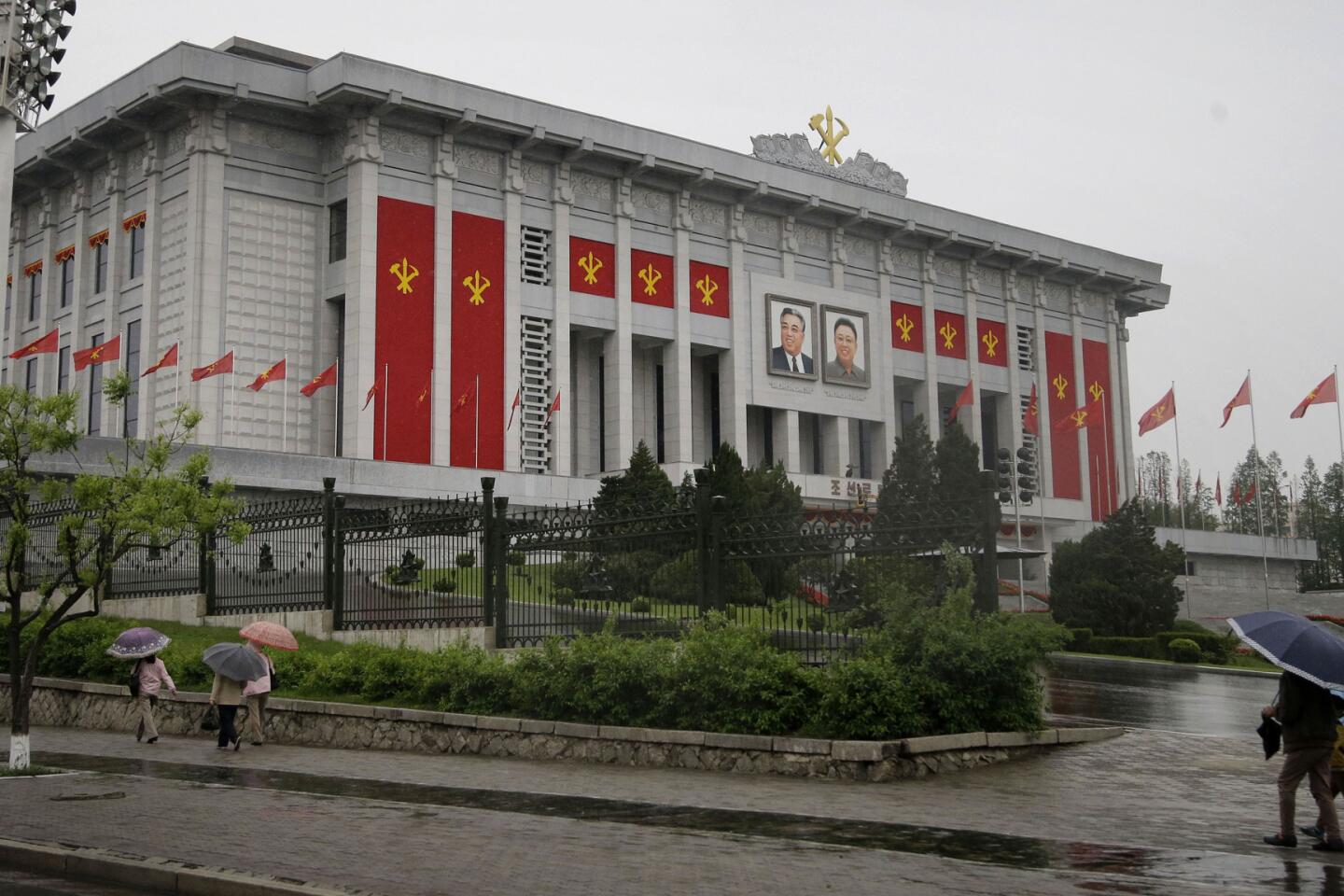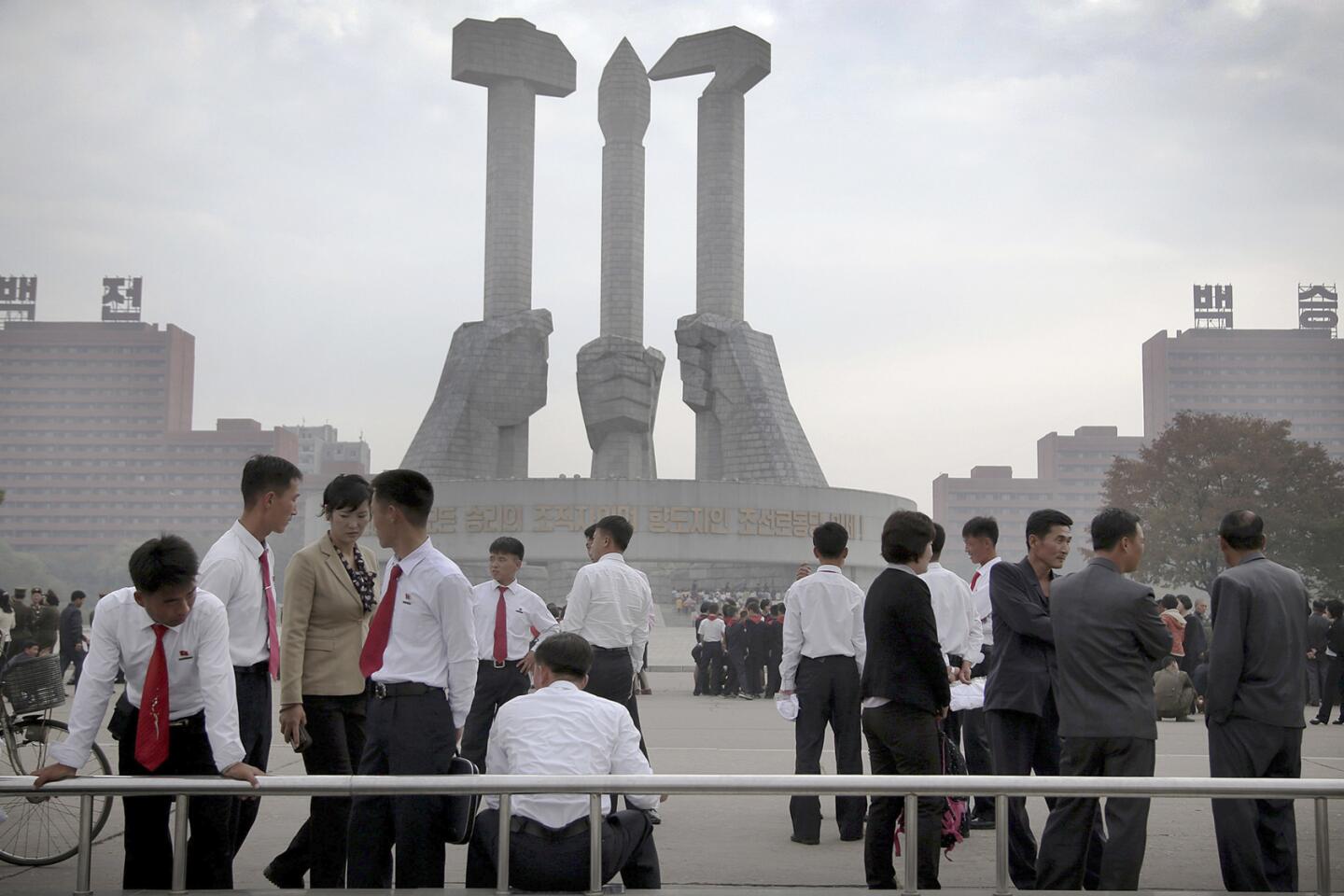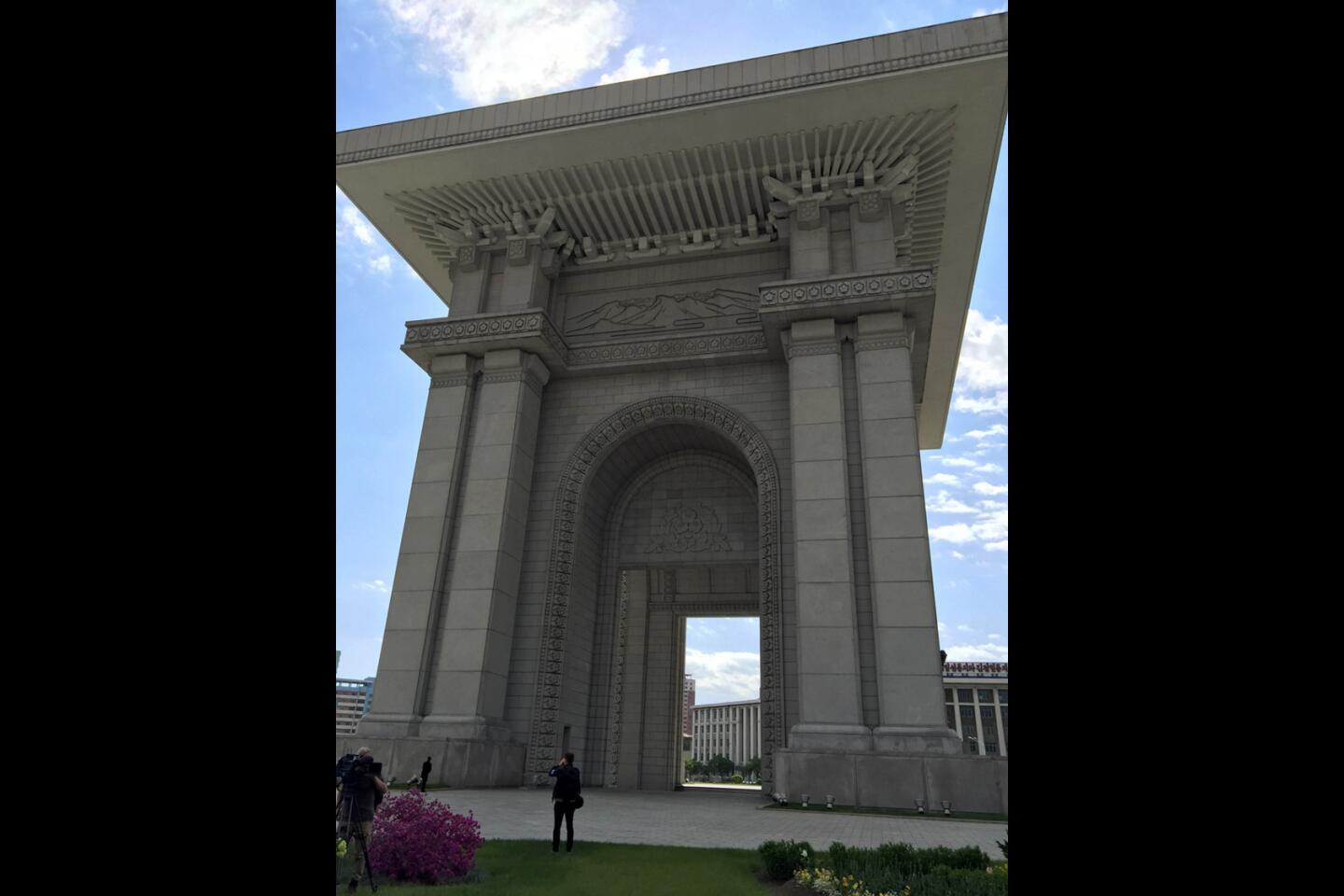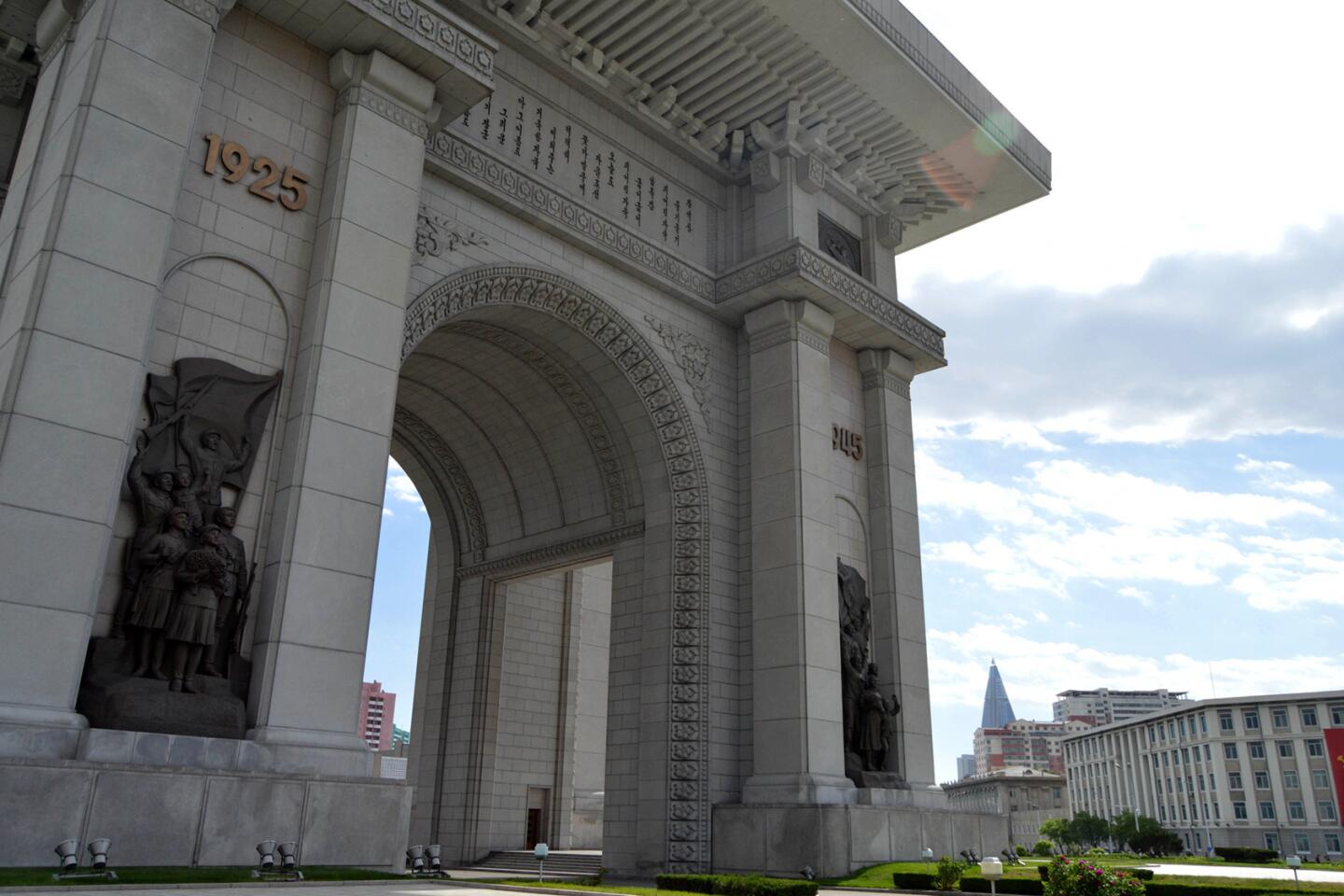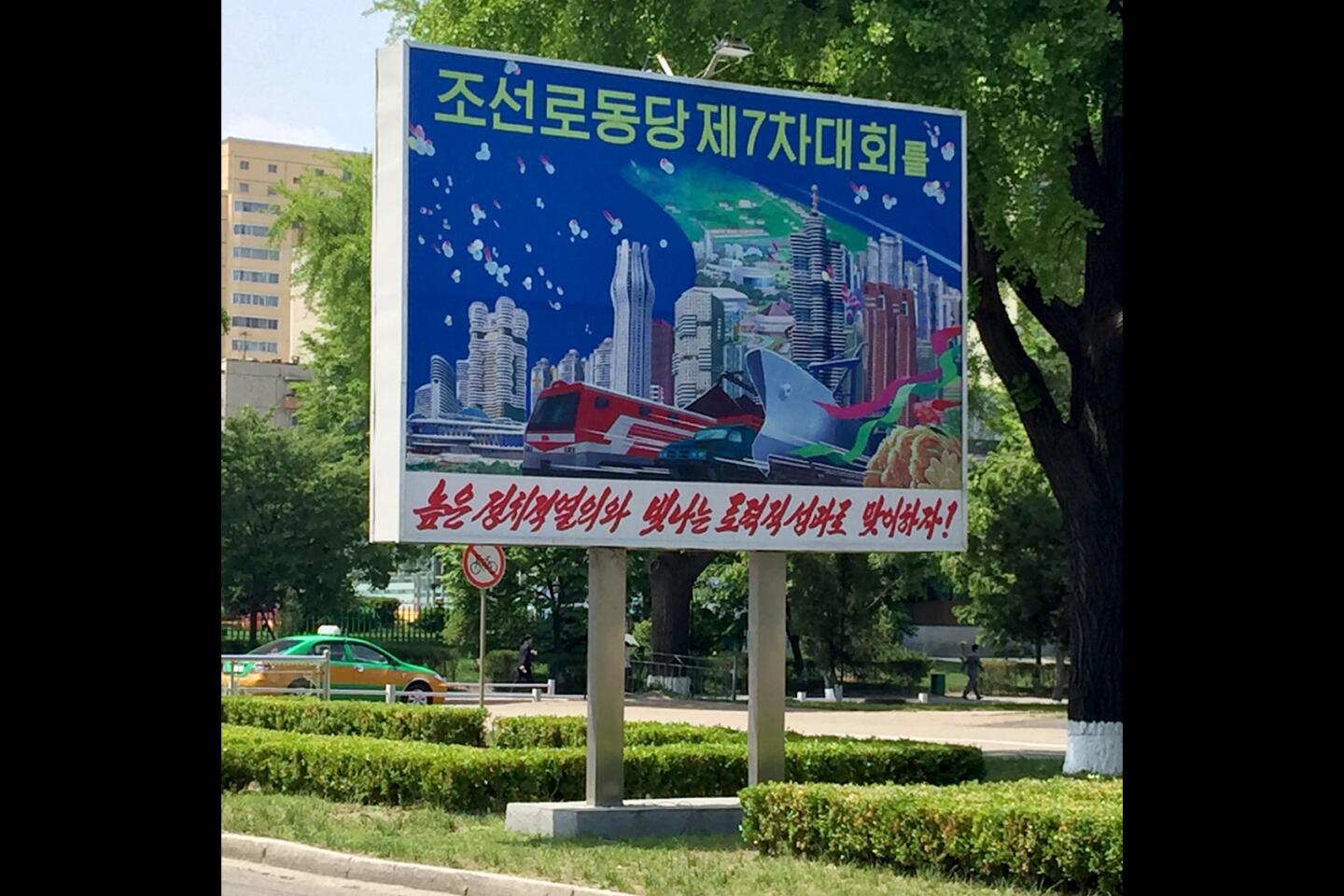North Korea is building something other than nukes: architecture with some zing
- Share via
Reporting from Pyongyang, North Korea — Soaring more than 50 stories, the new blue-and-white skyscraper at the top of Future Science Street cuts a Jetsons-like form. Its tower is crowned with a golden planet, and its sleek tiers of stacked oblong shapes call to mind a cartoon spaceport, ready to dock flying saucers. Down the block, two dozen other new apartment and commercial buildings in bold hues of orange and green and adorned with celestial logos glow brightly in the night, their sail-shaped facades reflected in the ripples of the Taedong River.
Downstream half a mile, a sleek metallic-and-glass group of buildings rise from Ssuk Island in the shape of a huge atom. Dubbed the Sci-tech Complex, the campus, opened last fall, houses an electronic library, reading areas and an “earthquake experience room,” and boasts of heating and cooling systems powered by solar, geothermal and other green energy sources.
For decades, North Korea’s capital has been seen by outsiders as a city frozen in time, with its Soviet-style squares, giant monuments, brutalist apartment blocks and ubiquitous propaganda billboards earning it appellations like “the world’s best-preserved open-air museum of socialist architecture,” and “the city that globalization forgot.”
Nearly wiped out during the Korean War in the 1950s, Pyongyang was rebuilt in subsequent decades as a sort of model socialist city, with drab, imposing buildings and a significant amount of green space. It was hardly known for being architecturally interesting.
But despite continued international sanctions and economic lethargy, supreme leader Kim Jong Un is giving the city a striking makeover that’s flooding its once-drab streets with color, loosening its formal vibe and even adding a smidgen of whimsy, while offering both residents and visitors myriad new opportunities for leisure, pleasure and consumption.
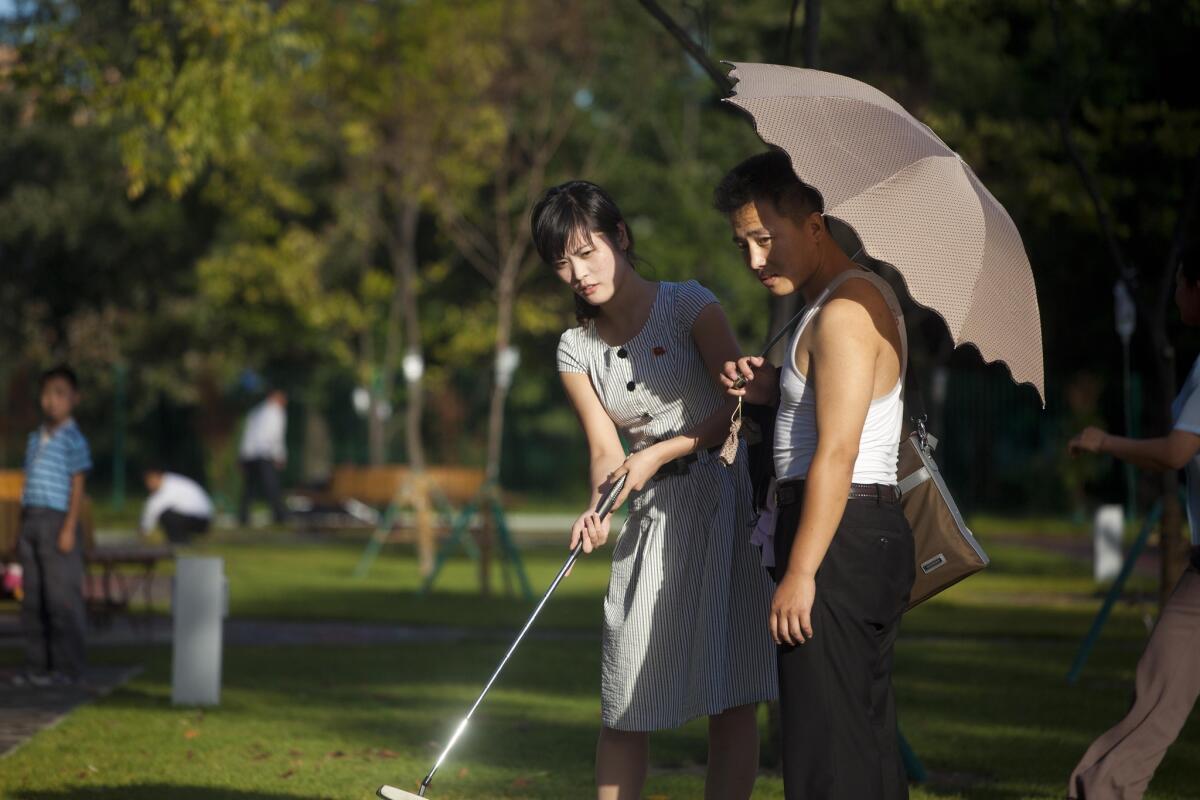
Since inheriting the reins of power in late 2011, the Swiss-educated Kim has largely eschewed the kind of grand arches, obelisks and statues and hulking government palaces that were the pet projects of his father and grandfather, Kim Jong Il and Kim Il Sung. Instead, the young leader has ordered up the construction of water parks, amusement parks, skating rinks, a dolphinarium and a ski resort.
New residential districts like Future Science Street and Satellite Scientist Street boast amenities like health clubs, pizza parlors and coffee shops. A shooting range opened in 2014 in central Pyongyang, while the more sedate can enjoy an excursion on the Rainbow, a 1,230-seat, 393-foot river cruiser that launched last October with a revolving restaurant on the 3rd and 4th floors.
Dotting the main thoroughfares are new snack kiosks, many of them plain, prefab sheds but a few shaped like cartoon animals. On the city’s outskirts, a new shiny glass-and-metal airport terminal welcomes tourists and business travelers with multiple gift shops and duty-free stores selling Remy Martin cognac and Marlboros.
“There’s been a huge amount of construction from 2010 onwards. The city is much more built up than when I first visited, in 2008, and the pace of development is much faster,” said Calvin Chua, a Singapore-based architect who has been running urban development and design workshops in North Korea since 2013 via a group called Choson Exchange.
In almost any other city, such shifts in the skyline would typically be regarded as the unremarkable result of routine cycles in the real estate market. But parsing the meaning of such changes in a long-insular communist state where architecture and urban planning have been tightly yoked with ideology for seven decades is less straightforward.
Some Pyongyang-watchers believe the changes are merely skin deep, and do not portend or reflect deeper political or economic changes. “There is still all this state influence. There is no free development. There is not a free market. It’s all ruled by the state vision of what North Korea can look like,” said Philipp Meuser, a German architect who in 2012 published the two-volume “Architectural and Cultural Guide Pyongyang.”
“The production of the city has not yet changed. Only the shapes of the buildings have changed.”
Much of the construction is still accomplished in the old way -- with labor from the military or youth “shock brigades.” The main material -- concrete -- is locally sourced.
But Chua has noted the apparent rise of what he calls “non-state entities” getting involved in North Korean building projects. In the last few years, North Korea has enacted new laws supposedly aimed at protecting foreign investors and establishing special economic zones. Since 2013, the state-run Korean Central News Agency has published multiple stories detailing projects involving architects and builders from China, Hong Kong, Singapore, Australia, the Middle East and Africa. The city of Wonson has urged overseas investors to come develop there.
“There is this thing among North Koreans about developing … an architecture that is reflective of their society. So what is an architecture that reflects their society? In ‘70s and ‘80s, it was a reinterpretation of [traditional] Korean architecture — things like tile roofs and columns” being added to Soviet-style neoclassic designs, said Chua. “Today, the interpretation is much more open-ended. That is something we are still trying to find out from them.”
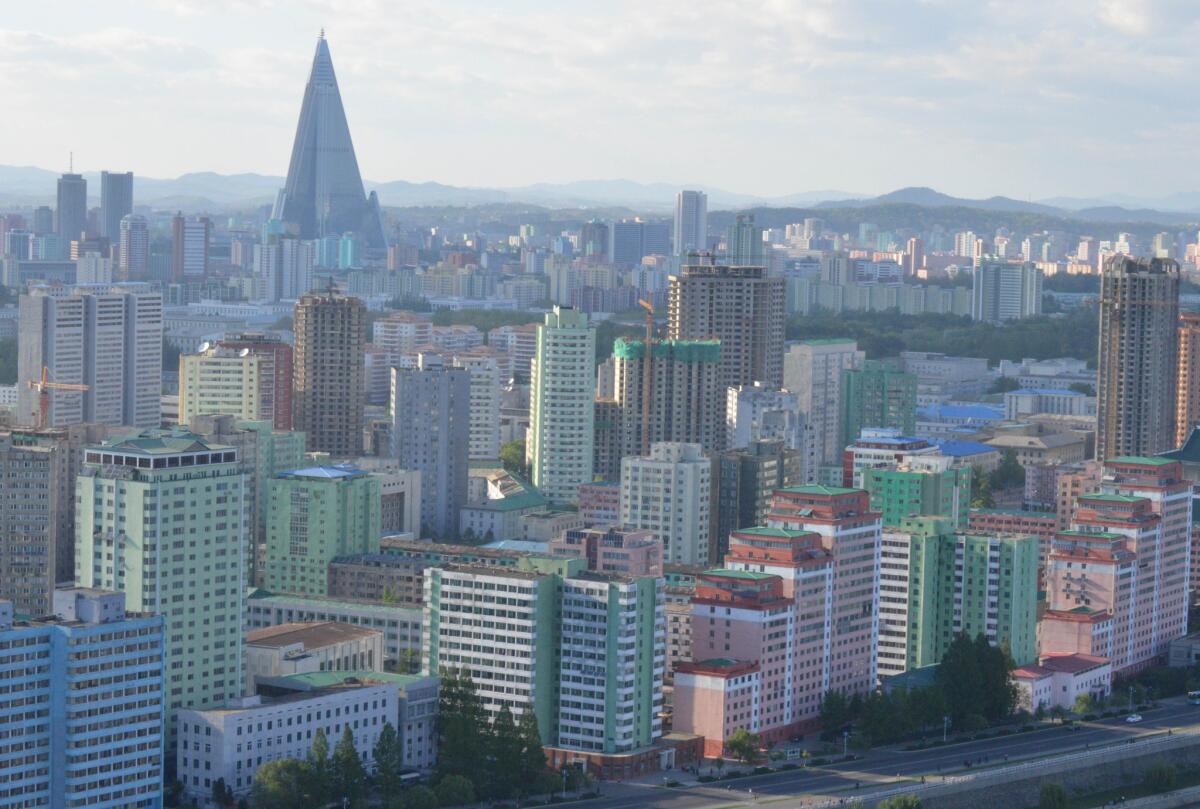
If North Korea has its own Frank Gehry or Zaha Hadid, it’s not saying — few of its buildings are credited to individual designers because architecture (like most things in the country) belongs “to the people.” But Pyongyang design — past, present and future — is increasingly attracting the attention of foreign architects, scholars, critics and hobbyists.
A year after Meuser published his book, travel company Koryo Tours launched architecture-focused tours of Pyongyang and has put out several issues of a magazine focused on the city’s iconic buildings. Chua, the Singapore architect, conducted a workshop last year in Pyongyang in conjunction with London’s Architectural Assn. and is returning in August for another focused on sustainable design.
Nick Bonner, founder of Koryo Tours, even organized an exhibit at Venice’s 2014 Architecture Biennale, commissioning a North Korean architect to envision new structures for the ever-larger numbers of tourists flocking to the country. The result was a hand-drawn technicolor dreamscape of conical, solar-powered mountain hotels linked by slides, cantilevered Frank Lloyd Wright-esque villas and tree-shaped retreats where visitors travel via helicopter-hovercrafts.
Cristiano Bianchi, an Italian architect based in Beijing, was so struck by what he saw on a trip to Pyongyang last year he’s launched a book project tentatively called “The Model City” that aims to explain the narrative patterns of the North Korean capital through nine stories about its structures, including its 300-foot-deep, ornate subway stations and its expanding examples of “informal” architecture like kiosks.
He’s animated in part by a sense that something is shifting in Pyongyang, with strong influence coming across the Chinese border as trade and tourism expand.
“Already, they are doing a lot of updating and modernizing of their ‘60s and ‘70s buildings,” he said. North Koreans are replacing “their very peculiar original designs -- made of brut concrete, mosaics, and terrazzo floors -- with a more modern and international style, with a large use of marble and glass surfaces,” he added. “More buildings will have the same destiny in the future.”
Meuser agreed. “They are core copying some elements from Chinese cities, and I would even go one step further and say … Pyongyang is losing its identity by copying Chinese commercial buildings,” he said.
While North Korean architects do stay abreast of international trends, says Bonner, information in the country is strictly controlled, and most architects in North Korea don’t have daily access to the Internet or even a particularly wide selection of current books and magazines.
“From time to time I’m contacted by the [North Korean] embassy, asking if I’ll speak to some North Korean architects coming to Germany,” said Meuser. “With the conditions they have, lack of good building materials and experience, they try to compensate by traveling and doing interviews with experienced architects from other countries.”
Some North Korean architects have trained in Europe and China, but even if they wanted to copy all the latest foreign designs, the lack of funds and building materials would limit their options. Concrete with rebar is still the primary material of choice, and construction standards still lacking. In a rare move, state-run media publicized the collapse of a just-built apartment block in May 2014. Although the reports did not detail the number of dead and injured, Kim Jong Un did visit a hospital, meeting injured workers and orphans.
Despite all the construction taking place, one project Kim has yet to complete is the massive, pyramidal Ryugyong Hotel. The 105-story concrete colossus, begun in 1987, has been called the “worst building in the history of mankind” by Esquire and “a luxury hotel designed for Mordor” by the Lonely Planet. It still looms unoccupied over the city, though an Egyptian telecom company seeking businesses dealings in North Korea did foot the bill for a glass exterior a few years ago.
For Kim, the Ryugyong may be a painful reminder of the danger of overreaching on massive, iconic projects that do little to please the populace. And besides, the city is so stuffed with monuments, there’s not exactly a crying demand for more.
“The symbolistic architecture is not needed in the moment,” said Meuser. “So they did the water park, and the ski resort... because they have to entertain the people.”
Follow @JulieMakLAT for news from China
MORE FROM NORTH KOREA:
North Korea’s big parade: ‘We have displayed the power of our military state’
North Korea detains, interrogates, expels BBC journalist
North Korea ruling party gives Kim Jong Un a grander title: Chairman
More to Read
Sign up for Essential California
The most important California stories and recommendations in your inbox every morning.
You may occasionally receive promotional content from the Los Angeles Times.
